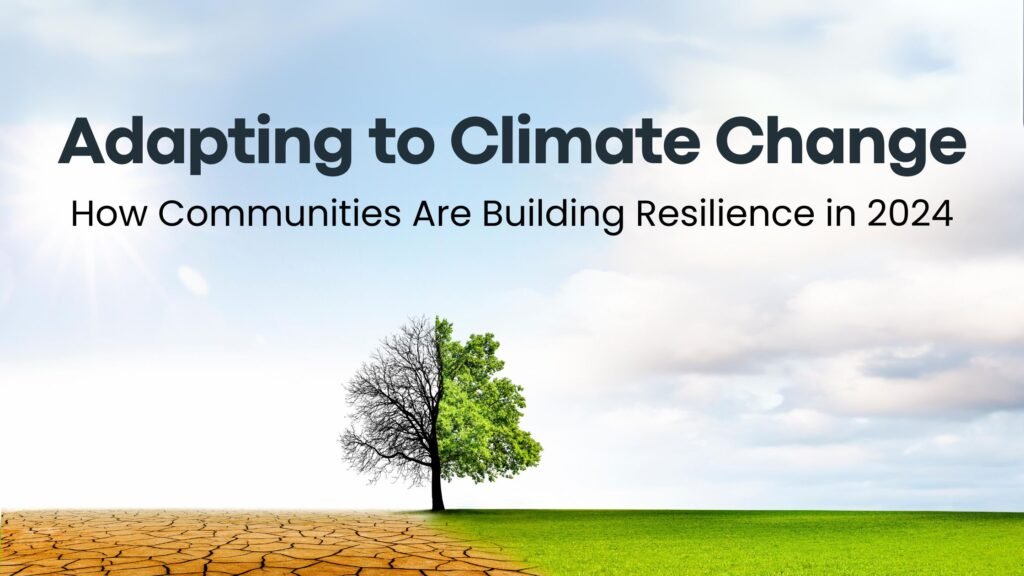Do you know how communities are building resilience to adapt to climate change in North America and Canada?
Well, in this article, we will explore the strategies and solutions being used to build resilience as communities across North America and Canada are facing more intense weather, rising sea levels, and other effects of climate change.
Understanding the Impact of Climate Change
Climate change is causing a significant change in weather patterns, which sometimes leads to more frequent and severe natural disasters such as hurricanes, floods, wildfires, and droughts.
However, these impacts are disrupting lives, damaging infrastructure, and threatening food and water security. Communities across the globe are taking action against these changes by integrating ways to deal with such issues and recognizing that mitigation alone is not enough.
Seeing the impacts
Climate change impacts our health, environment, and economy. For example
- Warmer temperatures increase the frequency, intensity, and duration of heat waves, which can pose health risks, particularly for young children and the elderly.
- Climate change can also impact human health by worsening air and water quality and increasing the spread of water diseases along with extreme weather events.
- Rising sea level threatens coastal communities and ecosystems.
- Increases in the frequency and intensity of extreme weather events, such as heat waves, droughts, and floods, can increase losses to property, cause disruptions to society, and reduce the affordability of insurance.
How are communities in Canada and the U.S. adapting to climate change?
As the impact of climate change becomes more concerning,communities across Canada and the United States are taking proactive steps to adapt and build resilience.
- Infrastructure Improvements
One of the most important ways in which communities are adapting to climate change is by improving infrastructure. In coastal areas that are vulnerable to rising sea level, to get out of such horrific situations, communities are building seawalls, elevating roads, and establishing buildings so that if storms arise, they are safe by taking such precautions.
However, in places where flooding is a concern, cities are redesigning drainage systems and creating green spaces that can absorb excess water.
For example, in Canada, cities like Vancouver are investing in “green infrastructure,” such as rain gardens and permeable pavements that can help manage stormwater naturally. These projects will not only reduce flood risks but also enhance urban environments, making them more livable and sustainable.
- Adoption Climate: Smart Agriculture
Agriculture has always been vulnerable when it comes to climate change because, with shifting weather patterns, it is always affecting crop yields and livestock productivity. In North America, people are adapting to climate-smart practices to build resilience. These include using drought-resistant crops, implementing efficient irrigation systems, and practicing no-till farming to maintain soil health.
- Community-Based Adapting Programs
Initiatives have been taken by communities for adapting and engaging local peoples in the planning to make implementation of ideas strategically for the betterment of the community.
However, in Canada, these communities are leading efforts to restore ecosystems, such as forests and wetlands, which provide natural protection against climate impacts by integrating traditional knowledge with modern science to develop strategies adaptively.
- Early Warning Systems and Public Education
Communities across the U.S. and Canada are enhancing early warning systems for natural disasters like hurricanes, floods, and wildfires so that if such disruptions occur, they can predict and prepare for precaution at the earliest.
According to the sources, the U.S. National Oceanic and Atmospheric Administration (NOAA) has improved its hurricane forecasting capabilities, while Canada has upgraded its Flood Forecasting and Warning Program to provide timely alerts to people.
Challenges in Building Climate Resilience
Navigating the complex challenges of building climate resilience in a rapidly changing world.
- Funding and Resource Limitations: One of the biggest challenges in building climate change resilience is the lack of sufficient funding and resources, which is the basic and foremost thing to mitigate with such issues. While large cities may have the potential to invest in projects, smaller communities often struggle to secure the necessary funds because of limited resources in indigenous communities.
- Political and Social Barriers: Lack of coordination among government agencies and willingness to change can impede the implementation of climate adaptation strategies. Additionally, lack of awareness and social barriers is the root cause of misinformation, as it can hinder community efforts to build resilience.
- Uncertain Climate Projections: Uncertainty is the integral part of climate change projections. It arises from natural visibility, model and scenario uncertainty, and from our incomplete knowledge regarding earth system dynamics.
- Disproportionate Impacts on Vulnerable Populations: Climate change does not affect everyone equally, the most affecting groups are the vulnerable communities, who have low income and are economically unstable because of limited resources. These kinds of groups always lack the financial means, information, and political power to adapt effectively to such situations.
Solutions for Enhancing Climate Resilience
Here are some innovative solutions from us to build resilience against the challenges of climate change.
- Increasing Access to Funding
To overcome the challenge of funding, governments and international organizations should work together to increase access to financial resources for climate resilience projects. In Canada, the federal government has launched initiatives like the Disaster Mitigation and Adaptation Fund (DMAF), which provides funding for large-scale infrastructure projects that reduce the risk of natural disasters.
Additionally, people should provide efforts to encourage private sector investment in resilience through public-private partnerships.
- Promoting Collaboration and Partnerships
To improve climate change issues, everyone should be cooperative to take initiatives that require a collaborative approach. With the help of governments, NGOs, and communities, everyone needs to work together to develop and implement effective strategies. However, the impact of climate change must together draw solutions that address these complex issues by identifying responses that span social, economic, and political boundaries and addressing impacts that can manifest anywhere from tomorrow through to 100 years and further into the future.
Moreover, it will require appropriate planning and management. This will be easier and more cost-effective if there is collaboration within and between organizations. Collaboration is not only needed to address the climate change issues and sea-level rise but also to identify and realize the benefits from any potential opportunities.
- Enhancing Education and Awareness
Raising awareness about the importance of climate resilience is crucial for gaining public support. Implementation of strategies should be there for building a culture of resilience, as community building is an essential tool. There should be a proper aim to educate citizens about the risks of climate change and the steps they should take to protect themselves and their communities.
- Fostering Innovation and Research
Innovation is the key to developing new solutions for climate resilience. As the National Climate Resilience Framework, becoming a climate resilience nation requires developing and deploying new and enhanced tools in our nation to address climate-related threats. The Climate Resilience Game Changers Assessment highlights innovative technologies, practices, and strategies that, with additional research, development, and investment, can become critical tools.
These game-changing technologies include advanced grid control systems for our energy sector, next-generation desalination and recycling technologies for our nation’s water, and resilience hubs that support public safety and promote community health.
5. Prioritizing Equity in Resilience Planning
It’s important to ensure that climate resilience efforts are accessible to vulnerable groups of people. This involves tailoring adaptation strategies in such a way that they meet the specific needs of different communities, and it’s crucial to ensure that resources are distributed fairly to everyone.
However, it includes access to healthcare facilities as a part of resilience planning for the group of people who lack such basic needs to sustain their daily lives.
Final thought
I hope this article helps you in gaining insights to achieve understanding of the solutions and benefits to build resilience to adapt to climate change in North America and Canada.
Plus, by adopting such strategies, communities can deal with such intense climate change issues and can enhance their quality of life in a better way.
To learn more about such strategies, you can follow our article and get more latest information.








Leave a Reply